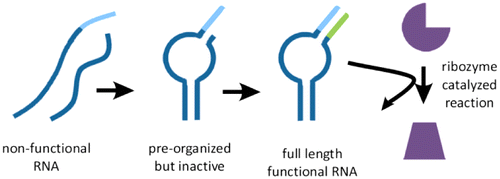Generation of functional RNAs from inactive oligonucleotide complexes by non-enzymatic primer extension
Katarzyna Adamala, Aaron E. Engelhart, and Jack W. Szostak
Journal of the American Chemical Society, 2015, 137(1), pp 483-489.
doi: 10.1021/ja511564d
Publisher | ResearchGate | PubMed | Google Scholar
Scientific Abstract
The earliest genomic RNAs had to be short enough for efficient replication, while simultaneously serving as unfolded templates and effective ribozymes. A partial solution to this paradox may lie in the fact that many functional RNAs can self-assemble from multiple fragments. Therefore, in early evolution, genomic RNA fragments could have been significantly shorter than unimolecular functional RNAs. Here, we show that unstable, nonfunctional complexes assembled from even shorter 3′-truncated oligonucleotides can be stabilized and gain function via non-enzymatic primer extension. Such short RNAs could act as good templates due to their minimal length and complex-forming capacity, while their minimal length would facilitate replication by relatively inefficient polymerization reactions. These RNAs could also assemble into nascent functional RNAs and undergo conversion to catalytically active forms, by the same polymerization chemistry used for replication that generated the original short RNAs. Such phenomena could have substantially relaxed requirements for copying efficiency in early nonenzymatic replication systems.
Lay Abstract
One common theory about how life started is that, instead of the DNA, RNA, and proteins found in modern cells, RNA alone was capable of performing both metabolic and information transfer tasks. This theory arose from work in the last 30 years showing that RNA itself can act as an enzyme or receptor, much like a protein. One central problem with the role of RNA in early life is that, if protein enzymes were not around, it would have been difficult to synthesize RNAs long enough to act as functional molecules themselves. In this work, we showed that even very short fragments of RNA can act as enzymes if they are treated with chemical reagents, thought to be plausible representatives of those present on the early earth. These reagents elongate the short RNA strands, enabling them to fold into enzymes and receptors. Thus, we showed that even very short RNAs generated by marginally effective copying reactions could have been converted to enzymes or receptors by very simple chemical reactions.
